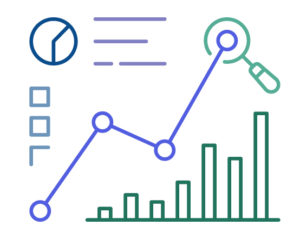
In today’s competitive employment landscape—where people are willing to jump from job to job—understanding and optimizing human capital is essential. Employers are increasingly recognizing that their employees are their most valuable assets. Effective measurement and management of human capital can significantly improve organizational performance. After all, if we can’t measure it, we can’t manage it.
This article defines key performance metrics that provide insights into workforce dynamics and offers strategies for analyzing the data to implement meaningful changes.
Essential Key Performance Metrics
1. Employee Turnover Rates
Employee turnover is a critical metric that reflects the stability and satisfaction of your workforce. High turnover rates can signal underlying issues such as poor management, inadequate compensation, or a toxic workplace culture. By tracking turnover rates, facilities departments can identify trends and develop strategies to improve retention. For instance, high turnover among new hires may indicate a need for better onboarding processes or more realistic job previews during recruitment.
2. Training and Development Stats
Investment in training and development is necessary for maintaining a skilled and competent workforce. Metrics—such as the number of training hours per employee, participation rates in training programs, and engagement in and satisfaction with training offerings—are a good starting point. By analyzing these stats, facilities departments can assess their training programs’ effectiveness and identify areas for improvement. For example, if certain training programs have low participation and satisfaction ratings, it may be time to revamp the curriculum or delivery method.
Another common issue is a lack of awareness of the training that the institution offers. Be sure your staff is aware of training opportunities and given the time to attend during their workday.
3. Employee Satisfaction and Engagement Scores
Employee satisfaction and engagement are strong indicators of overall workplace health. Regular surveys and feedback mechanisms can help track these metrics. High satisfaction and engagement scores typically correlate with higher productivity, better customer service, and lower absenteeism. Analyzing these scores can reveal what aspects of the workplace are working well and what areas need attention. For instance, low engagement scores in a particular unit may indicate issues with leadership or team dynamics. It is important to select a survey instrument and stick with it to have data to compare year to year. Aim for a 70 percent completion rate annually. Offering incentives is a great way to encourage participation.
4. Productivity Measures
Productivity metrics—such as preventative maintenance work orders completed—provide insights into how efficiently your workforce is performing. These metrics can be tracked over time to identify trends and inform decision-making. For example, if productivity is declining, it may be necessary to investigate potential causes such as outdated processes, insufficient training, or employee burnout. Productivity measures will be different for each unit within your facilities department. Collaborate with unit leaders to identify the best measures of productivity for their specific mission.
Analyzing the Data
Collecting data is only the first step; the real value lies in analysis. It is important to remember that humans are more than numbers. Use the numbers as a jumping-off point in your investigation.
 Here are some strategies for effectively analyzing human capital metrics:
Here are some strategies for effectively analyzing human capital metrics:
Identify Patterns and Trends: Look for patterns in the data over time. Are there certain times of the year when turnover spikes? Do engagement scores dip after major organizational changes? Identifying trends can help pinpoint root causes and inform proactive strategies.
Segment the Data: Break down metrics by department, job role, or demographic factors to gain a more nuanced understanding. This can reveal specific areas that need attention and help tailor interventions more precisely.
Benchmark Against Industry Standards: Compare your metrics to industry benchmarks to see how you stack up against competitors. APPA FPI data is a great place to start. It can provide context for your data and highlight areas where you are excelling or falling behind.
Implementing Meaningful Change
Once you have analyzed your data, the next step is to implement changes that will drive improvement. Here are some strategies for making meaningful changes based on your human capital metrics:
Develop Targeted Initiatives: Use your analysis to create targeted initiatives. For example, if turnover is high among mid-level managers, consider implementing a leadership development program. If engagement is low, explore ways to enhance employee recognition and feedback mechanisms.
Set Clear Goals and Monitor Progress: Establish clear, measurable goals for improvement and track your progress over time. Regularly review your metrics to see if your initiatives are having the desired impact, and be prepared to adjust your strategies as needed.
Foster a Culture of Continuous Improvement: Encourage a culture where feedback is valued and continuous improvement is a shared goal. Involve employees in the process of analyzing data and developing solutions. This can enhance buy-in and ensure that initiatives are aligned with the needs of the workforce.
As we continue to explore human capital as our most valuable asset, it is important to focus on the human. Data-driven decisions are an industry buzz term we have been hearing for years. As we move deeper and deeper into the world of data, we potentially move farther and farther from the human. It is important that we do not let data drive our decisions but let it inform our decisions. Data is a launching point for critical thinking and exploration. A quantitative data point is the beginning of a qualitative exploration. It is an opportunity to explore human factors of influence, such as bias, errors, and inconsistencies. Context should also be considered. You, as a department leader, could look at a data set and interpret the meaning one way, and a frontline staff member could look at the same data set and see something entirely different. A data point is a diving board; collect your data and bravely plunge.
Lindsay Wagner, PhD, is the owner of The Knowledge Collaborative in Lake Havasu City, Arizona. She can be reached at [email protected]. If you would like to contribute to this column, please contact Lindsay directly.
Facility Asset Management
Covers the issues and challenges surrounding the management of a facilities department, including solutions for benchmarking performance measures, database and reporting systems, and professional and educational trends in facilities management. To contribute, contact Lindsay Wagner, field editor of this column.
See all Facility Asset Management.


